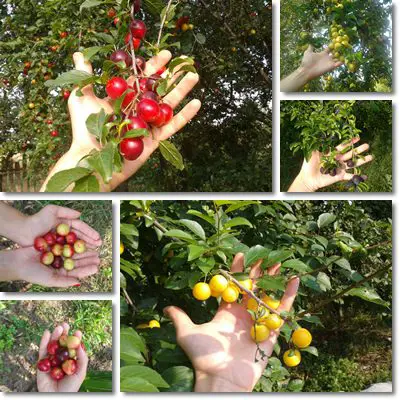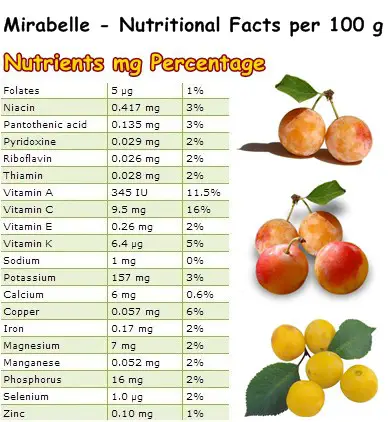The mirabelle (Prunus domestica syriaca), also called the mirabelle plum, is a fruit in the plum family, but not quite your ordinary plum. Mirabelles are the result of a cross between the myrobalan plum (Prunus cerasifera) and the blackthorn (Prunus spinosa).
What is interesting is that, despite their name, mirabelle plums are more closely related to their ancestor, the myrobalan plum, or the cherry plum and have the appearance and taste to prove it. The trees of the species can be found in the wild throughout Europe and even today they are highly appreciated for their delicious and healthy fruit.
Mirabelles are the fruit that most European centenarians grew up with and continue to eat on a regular basis. There is little research on their properties and health benefits because they are not usually the type of fruit sought after at the supermarket. But their appearance and taste profile reveal important information on their nutrient content and potential health effects.
There is also a long tradition of cultivation dating back hundreds of years and mirabelle plums can be found throughout France, Great Britain, Spain, Germany, Romania, Poland, the Czech republic, Slovakia and other European countries, just like their close relative, the cherry plum (or the myrobalan plum).

What do mirabelle plums look like?
The fruit are small, round or slightly oval-shaped and have an edible thin skin. The flesh is the same color as the skin, crisp and sour in unripe fruit and succulent, soft and sweet in the ripe fruit. It develops around a hard kernel or pit containing one bitter seed. The fruit actually look a lot like cherry plums, to which they are quite closely related. Mirabelle plums can range in color from green when unripe to golden-yellow and combinations of yellow and cherry-red or dark-red when ripe. Why is this so amazing? Because different colors in a fruit are indicative of various natural compounds with beneficial antioxidant effects.
What do mirabelle plums taste and smell like?
For example, when they are unripe, mirabelles are extremely sour-tasting which indicates that they are a rich source of in vitamin C, one of the most potent natural antioxidant and anti-inflammatory agents. As the fruit ripen, their flesh becomes soft and juicy and grows extremely sweet. They even acquire a sweet, fruity smell.
Romanians for example, use unripe, green mirabelles and cherry plums (yes, they are all green when they are unripe) in soup to make it sour. Other European countries use both mirabelle plums and the closely related cherry plums for making sour soups and sauces. The ripe fruit are commonly made into jam thanks to their high content of pectin which helps bind the fruit preserve, while a small percent of the fruit production goes into making a colorless alcoholic beverage called ‘eau-de-vie’ in French (literally ‘life water’), ‘palinca’ in Romanian and ‘pálinka’ in Hungarian.

Mirabelle plums nutrition facts
The golden-yellow varieties are rich in beta-carotene, a powerful natural antioxidant that protects us from free radicals and oxidative stress. Free radicals are harmful oxygen molecules which cause damage to cells, potentially leading to cancer-causing mutations. The fruit also contain antioxidant pigments like zeaxanthin and antioxidant flavonoids. These naturally-occurring compounds have multiple benefits such as lowering LDL cholesterol levels and blood pressure.
Red mirabelle varieties are a source of antioxidant pigments called anthocyanins which may also exert protective effects against cancer and chronic diseases in general. Anthocyanins protect cells against free radical damage and oxidative stress and contribute to lower inflammation levels in the body. Eating mirabelle plums or drinking juice made from them can have benefits for cardiovascular health, metabolism and even memory.
Other antioxidants in the fruit include: quercetin (a flavonoid with anti-viral and anti-inflammatory benefits), ellagic acid (a phytochemical known to purify blood), chlorogenic acid (also known as the coffee bean antioxidant, with benefits for diabetes and lipid metabolism), neochlorogenic acid, caffeic acid and flavanols. The dark-red and purple plum varieties are sources of resveratrol, also found in grapes and known to exert anti-aging benefits, slowing down the aging process and boost cardiovascular health.

Basically, mirabelles are a mix of powerful natural antioxidants with anti-inflammatory effects and other important phytochemicals, their rich palette being only a reminder of the numerous health benefits they bring via their antioxidant profile. As for their nutritional profile, mirabelle plums contain small amounts of several essential vitamins and minerals, the most notable being vitamins A, C and copper.
Nutritional facts for 100 g of mirabelle plums:
- 345 IU of vitamin A from antioxidant carotenoids, amounting to 11.5 % of the RDI
- 9.5 mg of vitamin C, representing a little over 10% of the current RDI
Unripe mirabelle plums have several times the vitamin C content of ripe fruit. - small amounts of vitamins B1, B2, B3, B5, B6, B9, E, K
- small amounts of copper, iron, magnesium, manganese, phosphorus, potassium selenium and zinc
- 46 kcal (kilo-calories) energetic value
- 11.5 g of carbohydrates, with 9.9 g of natural sugars
- 0.3 g of fat, no cholesterol
- 0.7 g of protein
- 1.4 g of dietary fiber, important source of pectin

What are the benefits of Mirabelles?
- Good for eyesight, skin and immunity thanks to a good vitamin A content.
- Strong antioxidant and anti-inflammatory properties.
- Good for preventing respiratory infections thanks to a good vitamin C content.
- Mild cholesterol and blood pressure-lowering properties.
- Tonic effects as a result of a good B vitamin and mineral content.
- Anti-aging properties from vitamins A, C, copper and other antioxidants.
- Good for memory and nervous system health (source study: Effect of Prunus domestica L. (mirabelle) on learning and memory in mice).
- Aid digestion, regulate transit time, relieve constipation and promote colon health.
- Good for hemorrhoids thanks to their fiber content.
- Have prebiotic benefits, feeding the good gut bacteria as a result of their good pectin content.
Conclusion
The best way to convince yourself if something is good for you is to try it and decide for yourself. The same is true for mirabelle plums. While they may not be the next blueberry or dragon fruit (but who knows?), they have a wonderful flavor profile and can provide important health benefits. I for one like sour mirabelle plums and find they help boost my immunity.
The ripe fruit help me combat constipation naturally and since starting eating them, it seems that my skin is glowing, I feel more energized and enjoy better digestion.
Once you taste the ripe fruit, I am certain you will want to eat some more, that’s how savory they are. Mirabelles have a sweet smooth flesh beneath the thin outer skin and, believe it or not, each variety has its own subtle flavor. They really do make a great jam fruit thanks to their generous pectin content and the trees are extremely prolific fruit bearers. A single tree might supply you with fruit to eat fresh, make fruit preserves, sweet and sour sauces and still have some left. And while they ripen towards the end of August, you can enjoy unripe, green mirabelle plums in sour sauces and sour soups starting with July.
